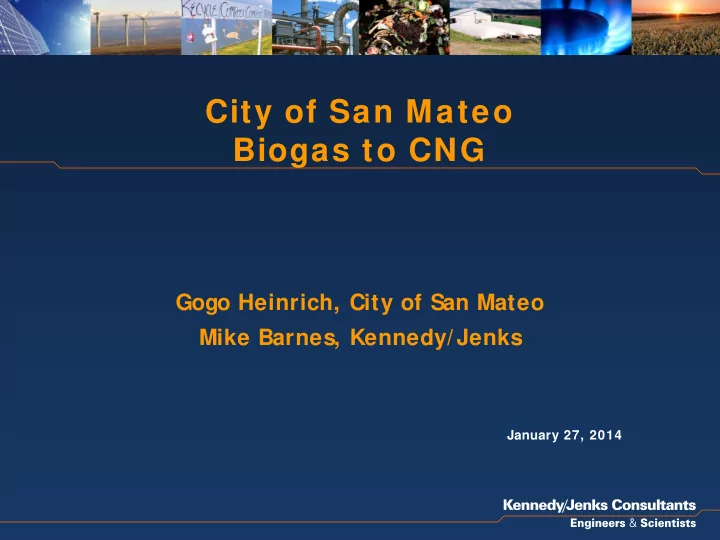

City of San Mateo Biogas to CNG Gogo Heinrich, City of San Mateo Mike Barnes, Kennedy/Jenks January 27, 2014
San Mateo WWTP Wastewater solids from WWTP with ADWF of 11.6 mgd Two egg shaped digesters 1.2 million gallon capacity each 100 cfm of digester gas available
Project Goals/Questions Develop project to use beneficially use the energy from the 100 cfm of digester gas Assess cost-effectiveness of CNG production for vehicle fueling Assess potential for increased gas production by adding high strength waste
Modifications Needed Digester gas treatment • Moisture • Siloxane • Carbon dioxide Gas storage Gas system controls Vehicle fuel storage and dispensing Converted vehicles to CNG
Vehicle Fueling Layout
Findings from the Study Digester capacity for high strength waste Can produce 500 GGE Existing utility vehicles could use about 280 GGE
Alternatives Financial Comparison Alternative Biogas Project Annual Annual Simple Cost O&M Savings Payback Costs Do Nothing - - - - Gas from WW 100 cfm $4.7 $0.21 $0.61 7.8 yrs solids only Gas from WW 200 cfm $8.0 $0.38 $1.81 4.4 yrs Solids & FOG
Key Variables for Successful Project Reliable gas treatment Vehicle conversion to CNG Need to use 500 GGE per day Contract for FOG or other high strength waste
Existing Gas Treatment Examples West Lafayette, IN Clean World Facility, CA
Existing CNG Storage Examples City of Millbrae Clean World Facility
GMC CNG Vehicle
Next Steps-General Confirm use of 500 GGE/day Consider addition of high strength waste to produce 1000 GGE/day Identify vehicles • San Mateo vehicles • County transit • School buses • Neighboring cities Consider Environmental impacts (CEQA)
Next Steps-Schedule Separate project • Design-build o 12 months o Quick reviews by City • Design-Bid-Build o 15-18 months o Typical review process Include with Corp Yard project
Next Steps-Predesign Gas system control (supply vs. demand) Assess need for gas storage Location of modifications Refine cost and payback
Questions?
General info slides
How Much Grease is Out There? Some Trap Grease Production Rates*: • National Avg. = 13.4 lbs/year/person • Sacramento, CA Avg. = 11.2 lbs/year/person • Provo, UT Avg. = 26.6 lbs/year/person * Source: Wiltsee, G. “Urban Waste Grease Resource Assessment.” NREL. November 1998
Food Waste
Food Waste 29 Million tons per year 17% of landfill volume
Food Waste Greenhouse gas emissions - methane and carbon dioxide of methane emissions (2 nd largest) 23% Lost opportunity
Recommend
More recommend